Parents and Birthplace
Jonas Olofsson was born in the village of Hedsta, farm #4 (also known as Sönnanbäcken, which means south of the brook) , Ljusdal parish, Gävleborg län, Sweden on 6 November 1851, the first child of farmer Olof Jonsson and Karin Nilsdotter. (Until late in the 1800s, Swedish wives retained their maiden names.) 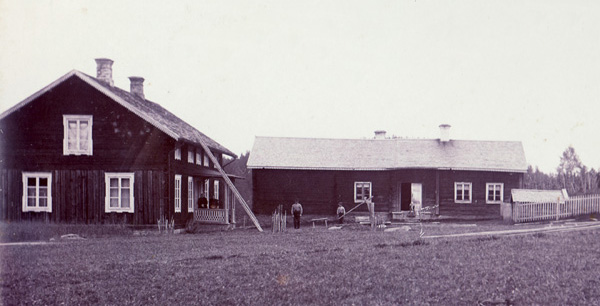 The church birth record does not include a middle name for Jonas. Ljusdal is located about 200 miles NNW of Stockholm and is one of about 2500 parishes in Sweden. In 1850, Ljusdal parish was composed of about 4,000 people living in 65 villages.
The church birth record does not include a middle name for Jonas. Ljusdal is located about 200 miles NNW of Stockholm and is one of about 2500 parishes in Sweden. In 1850, Ljusdal parish was composed of about 4,000 people living in 65 villages.
Jonas’ father, Olof, was born in the nearby village of Letsbo on 20 April 1822, the first child of tenant farmer Jonas Olofsson (1798-1879) and Sigrid Jonsdotter (1799-1884). Jonas’ mother, Karin, was born in the village of Råggärde on 3 July 1824, the daughter of soldier Nils Plat (1779-1867) and Kjerstin Pehrsdotter (1788-1848).
Olof married Karin on 14 April 1850 in Hedsta. Olof and Karin had two additional sons, Olof (1855-1923) and Nels (1857-1870), both born at Sönnanbäcken.
The primary crops raised in Ljusdal were rye for bread, oats for animal feed, potatoes for eating and flax for weaving.
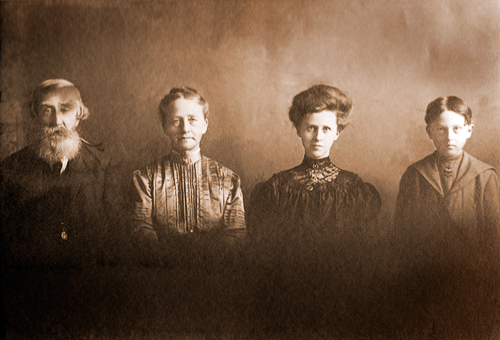 Jonas “spent his youth quietly and uneventfully with his parents. The lad having desire and ability to learn easily, soon completed the instruction of the public school." Education for children 7 to 14 years old had been free and compulsory in Sweden since 1842. "At the age of sixteen he was confirmed by Pastor Karl Oscar Roos.” “ In his youth, Lundberg came in contact with the so-called Norrland’s Pietists. They gathered often around the Word of God and someone read one of Luther’s sermons. In this circle it soon became evident that the 17-year old Lundberg was in soul and heart one with them and ... they finally chose him as their reader.” (A Century of God’s Grace at Svea Evangelical Lutheran Church 1870-1970. Willmar, MN, 1970, p. 62)
Jonas “spent his youth quietly and uneventfully with his parents. The lad having desire and ability to learn easily, soon completed the instruction of the public school." Education for children 7 to 14 years old had been free and compulsory in Sweden since 1842. "At the age of sixteen he was confirmed by Pastor Karl Oscar Roos.” “ In his youth, Lundberg came in contact with the so-called Norrland’s Pietists. They gathered often around the Word of God and someone read one of Luther’s sermons. In this circle it soon became evident that the 17-year old Lundberg was in soul and heart one with them and ... they finally chose him as their reader.” (A Century of God’s Grace at Svea Evangelical Lutheran Church 1870-1970. Willmar, MN, 1970, p. 62)
The above is a highly significant quotation. In 1726 Sweden had passed the Conventicle Act, "prohibiting all religious assemblies outside the state church". Although the Act was repealed in 1858, "it would take a long time ...before the Pietists and their followers were accorded equal status with the state church, and therefore they still considered themselves the object of official persecution." (Ljungmark, Lars. Swedish Exodus. Carbondale: Southern Illinois University Press, 1979, p. 32-33)
The family lived at Sönnanbäcken until 1862 or 1863, when they sold the farm and moved to a smaller house and parcel of land in the nearby village of Hamre. Apparently Olof Jonsson had fallen ill, probably with tuberculosis, and was unable to manage the farm. The family survived on the proceeds of the farm sale until Olof died on 9 June 1868 at age 46, only three days after the entire family had received documents permitting emigration to North America.
Why did Jonas change his last name? In Sweden, the patronymic naming convention for surnames was for the son to take the given name of his father and add “son” and for the daughter to take the given name of her father and add "dotter". Thus Jonas Olofsson would have been Jonas, son of Olof. However, by the middle of the 19th century, Swedes were beginning to construct nonpatronymic surnames. Lundberg is a combination of the word “lund” for woods and “berg” for mountain. We believe that the family took the Lundberg surname after leaving Sweden because they believed it would be less common than “Olofsson” (or the shortened “Olson”) in their new homeland. The change in name is not recorded in the official Ljusdal parish records. Subsequently, “Lundberg” became one of the most common nonpatronymic surnames in Sweden. Jonas continued to change his given name over time, to "John", then to "John Ole", "Johan Olof" and finally the initials "J.O."
Emigration to America
In the summer of 1868, not long after the death of his father, Jonas (age 16) and his mother and brothers left for North America. Why did they decide to emigrate? We do not know. However, there are 3 good possiblities. First, Sweden had significant crop failures in 1866 and 1867; 1868 also, but by then they had departed. Second, the family had three boys and they owned only a house and a small plot of land, far too small to provide sufficient income. Third, prospects in the United States brightened with the passage of the Homestead Act in 1862 and the end of the Civil War in 1865. The Homestead Act offered the promise of free land for those willing to settle the frontier and cultivate the land.
Attitudes among the Swedish aristocracy were very negative and illustrated the strong class distinctions that might also have motivated emigration from Sweden. Hans Mattson, a well-known Swedish American at the time, wrote the following about his first return trip to Sweden (after his emigration 18 years earlier) in 1868: "The laboring and middle classes already at that time had a pretty correct idea of America, and the fate that awaited emigrants there; but the ignorance, prejudice and hatred toward America and everything pertaining to it among the aristocracy, and especially the office holders, was as unpardonable as it was ridiculous. It was claimed by them that all was humbug in America, that it was the paradise of scoundrels, cheats and rascals, and that nothing good could possibly come out of it. They looked upon emigrants almost as criminals, and to contradict them was a sure means of incurring their personal enmity and even insult". (Mattson, Hans. Reminiscences, the Story of an Emigrant. Saint Paul: D.D. Merrill Company, 1892, p. 111)
During a time of industrialization, why didn't the family move from their rural home to an urban area like Stockholm? At that time almost 90 percent of the population lived in rural areas. By 1868, a number of groups had already left Hälsingland and established successful agricultural communities in America. Swedes with a farming background saw a better opportunity to continue their way of life in rural America than in Stockholm. In addition, "many felt that the Swedish economy was excessively sluggish, if not stagnant, and their views were shared by returning emigrants as well as those who stayed in America and sent back glowing reports of land and job opportunities". (Ljungmark, Swedish Exodus, p. 31)
By contrast, "America was a Canaan, an Eldorado, or a Utopia, and the advantages of agrarian America as well as her natural beauty were extolled. This view was based on the paradise myths where happy people exist in the natural state, and America was the garden of the world. The picture was strengthened by reports of cheap land in America, of the possibilities for an autonomous, self-sufficient agriculture, and of the freedom from employers and landlords. Much of that picture of America was the result of a commercial stereotype" promoted by shipping companies and American states and railroads. (Norman, Hans and Runblom, Harald. Transatlantic Connections: Nordic Migration to the New World after 1800. Oslo: Norwegian University Press, 1988, p. 45)
After the family decided to emigrate to the United States, why did they choose Minnesota as their destination? In 1867, the Minnesota legislature authorized the formation of the State Board of Immigration which began promoting the "wonderful climate" and free government land available in Minnesota. Hans Mattson, Secretary to the Board, wrote many articles and letters for Swedish language newspapers in the United States. Frequently Swedish pioneers who had already settled in Minnesota forwarded those positive articles and letters to their relatives and friends in their homeland. (Ljungmark, Lars. For Sale - Minnesota. Chicago: The Swedish Pioneer Historical Society, 1971, p. 35) Also, St. Paul & Pacific Railroad ads published in U.S. newspapers advertised "Half a million acres of railroad land along their Branch Line " comprising "timber, meadow and prairie lands and all...within easy distance of the Railroad, and in the midst of considerable settlements, convenient to schools and churches" at prices ranging from 5 to 10 dollars per acre with easy long term credit. (The Minnesota Guide. St. Paul: E. H. Burritt & Company, 1869; republished in a facsimile edition by Applewood Books, Bedford, Massachusetts)
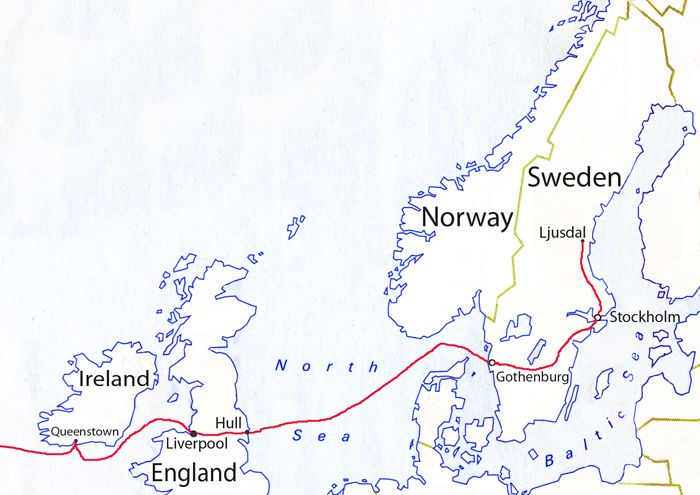
Moreover, transportation had improved significantly. With the recent introduction of transatlantic steamships, passage from Liverpool to New York could be made in less than 14 days versus a typical 44 day voyage on a sailing ship. Also, "the number who died during the passage decreased from 1 per 184 passengers on sailing ships to 1 per 2,195 passengers on the steamers". (Norman and Runblom, Transatlantic Connections, p. 115) Railroad construction on both sides of the Atlantic had also shortened the time and reduced the cost of overland travel.
Jonas and his family were among the first large wave of emigrants from Sweden. According to official statistics, 21,472 people left Sweden in 1868 joining the 35,000 that had left since 1851. By 1930, almost 1.25 million people had emigrated, about 20 percent of the population. (Ljungmark, Swedish Exodus, p. 10, 145)
Most likely, the family traveled by rail from their home to the port of Gothenburg on the West coast of Sweden. Then they took a two day, 600 mile, steamship voyage across the North Sea to Hull, a port on the East coast of England. The family would have had to bring their own food for this part of the trip. After a 3-hour, 120-mile, railway journey, they arrived in Liverpool, the major port on the West coast of England. On 2 July 1868 Carin Nilsdotter, with her children, Jonas, Olof and Nils, boarded the SS Austrian in Liverpool for the 11-day transatlantic voyage to Quebec, Canada. Food was provided by the steamship company. There were 472 passengers on board and the family was among the 424 people in 3rd class, or steerage.
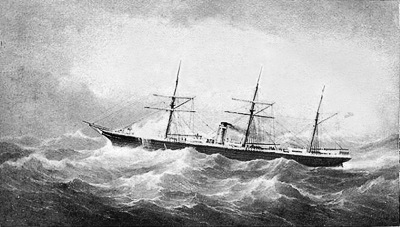 On the left is a photograph of a painting of the SS Nestorian, the sister ship of the SS Austrian. The SS Austrian, built in Glasgow in 1867 for the Canadian-owned Montreal Ocean Steamhip Company (also called the Allan Line), was 319 feet long and had a single smokestack, iron construction, 3 masts rigged for sail and rated speed of 11 knots. (Swiggum, Gery & Sue. Passenger Ship Arrivals Canadian Ports 1865-1899. CD-ROM, Wellington, Nova Scotia:TheShipsList-Research Inc., 2002) "Though powered by steam the Atlantic liners of the 1860s and 1870s were equipped with sails that could be used for additional speed in brisk tail winds". (Ljungmark, Swedish Exodus, p. 77) (photograph courtesy of http://www.norwayheritage.com)
On the left is a photograph of a painting of the SS Nestorian, the sister ship of the SS Austrian. The SS Austrian, built in Glasgow in 1867 for the Canadian-owned Montreal Ocean Steamhip Company (also called the Allan Line), was 319 feet long and had a single smokestack, iron construction, 3 masts rigged for sail and rated speed of 11 knots. (Swiggum, Gery & Sue. Passenger Ship Arrivals Canadian Ports 1865-1899. CD-ROM, Wellington, Nova Scotia:TheShipsList-Research Inc., 2002) "Though powered by steam the Atlantic liners of the 1860s and 1870s were equipped with sails that could be used for additional speed in brisk tail winds". (Ljungmark, Swedish Exodus, p. 77) (photograph courtesy of http://www.norwayheritage.com)
The family probably took a 2 1/2-day Grand Trunk Railway trip from Quebec to Detroit, where they entered the United States in July, 1868. They boarded a Michigan Central Railroad train to Chicago, a Chicago & Northwestern train to Madison, a Milwaukee and Prairie du Chien train across the Northeast corner of Iowa to Austin, a McGregor and Western train to Owatonna and a Minnesota Central train to Mendota. Since there was not yet a railroad bridge across the Mississippi at this location (a bridge would be opened in 1869), they would have taken a ferry and then a horse-drawn wagon to downtown St. Paul. There they boarded the recently constructed St. Paul & Pacific Railroad and traveled 48 miles northwest along the eastern side of the Mississippi River to the town of Big Lake in Sherburne County Minnesota. Clearly, this was before the era of railroad consolidation. (Prosser, Richard S.. Rails to the North Star. Minneapolis: University of Minnesota Press, 1966, p. 12)
This must have been a tiring 23 day trip for the family, covering more than 6,000 miles from their home in Sweden to their new home in Minnesota. The cost of a trip from Gothenburg to Chicago was about $41 at that time, half price for children under 12. This compares to farmhand wages in Sweden (after room and board) of about $27 per year. A farmhand in America could earn 2 to 3 times as much. (Ljungmark, Swedish Exodus, p. 44)
The United States, under President Thomas Jefferson, purchased the land encompassing most of Minnesota from France, then led by Napoleon Bonaparte, on 2 May 1803. This "Louisiana Purchase" now includes 14 U.S. states and comprises about 23 percent of the land area of the current United States. The Territory of Minnesota was first organized in 1849, when the population of 6,000 was largely devoted to the fur trade. When Jonas and his family arrived in 1868 Minnesota had been a state for only 10 years and population had grown to 440,000, of whom 160,000 were immigrants. (Young, Edward. Information for Immigrants. Philadelphia: Samuel D. Burlock, 1871, p. 231)
Railroads were new to Minnesota. In an era when roads ranged from non-existent to primitive and river transportation was limited by severe Minnesota winters, railroads were necessary to extend the frontier of civilization. Only railroads could cost effectively bring the farmer's grain to urban markets and bring manufactured goods to the farm. The first passenger train in the state traveled 10 miles between St. Paul and St. Anthony (now Minneapolis) on 28 June 1862. By 1868, the Town of Big Lake was almost as far west as you could go by rail in Minnesota. Two St. Paul & Pacific trains a day left St. Paul at 8:00 AM and 2:30 PM for the 3 1/2 hour trip to Big Lake. (St. Paul Dispatch. 25 July 1868, p. 2, col. 6) Note the ambitious name of St. Paul & "Pacific". The undercapitalized regional owners of the railroad, partially financed by English and Dutch bondholders, hoped to one day reach the West Coast. After James J. Hill took over in 1879, he pushed what would become the Great Northern Railway all the way to Seattle in 1893.
The family “took a homestead” and labored to clear the land and build a home. Jonas and his family wanted to gain financial security by again becoming land owners. While getting the farm underway, Jonas earned money by working in the woods during the winter and on the railroad during the summer. (A Century of God’s Grace, p. 62) Although Jonas was only 16 at the time, he needed to support the family because of the death of his father.
“For a dollar a day, payable in the spring when the seasonal onslaught on the virgin forest temporarily stopped, lumbermen felled trees, sawed them into lengths that sawmills could handle, and hitched them behind horses, oxen, or locomotives that towed the lumber over an iced “skid road”. Camps worked two-week stints before a day’s holiday (usually a Saturday)”. (Schlereth, Thomas J. Victorian America - Transformations in Everyday Life 1876-1915. New York: HarperPerennial, 1991, p. 48) The lumber from the Northern woods was used primarily for ties and fuel for the rapidly expanding railroads and for urban homebuilding. More local rural sources were used for home heating and homebuilding.
Life was hard in Big Lake Township. In January 1870, Jonas' brother, 12 year old Nels Lundberg, died of typhus fever in Sherburne County. (1870 US Census, Big Lake Township, Sherburne County, Minnesota)
On 23 April 1870 Jonas' mother, now known as Carrie Nelson (Americanized form of her birth name, Nilsdotter), married Peter Peterson in Big Lake Township. Carrie was 46 years old and brought to the marriage Jonas, 19, and Ole, 15. Peter, age 36, a Norwegian-born farmer and widower had 3 younger children: Mary, 8, Peter, 5, and Henry, 3, all born in Norway. Carrie and Peter were married by justice of the peace S.A. Putnam. This was early in the German and Scandinavian immigrant period. Settlers in Sherburne County were primarily Anglo-Americans. Lutheran churches had not yet been established. (Sherburne County Marriage Register, Recorder's Office, Sherburne County Government Center, Elk River, Minnesota; 1870 US Census)
The family lived on an 80 acre farm (5 acres improved) in Big Lake Township. According to the July 1870 US Census, the farm produced 50 bushels of Irish potatoes, 200 pounds of butter, 100 pounds of cheese, 20 tons of hay, 10 bushels of spring wheat, 20 bushels of Indian corn, and 20 bushels of oats. Livestock included 3 milk cows, 4 other cattle (probably at least 2 were oxen used as draft animals), and 1 pig. No horses were listed. The total value of the farm was $1,000. (1870 US Census) The family was working hard to homestead the land, with the hope of owning it free and clear after 5 years. However, the records do not show success. Big Lake is in the flood plain of the Mississippi River and has light sandy, not very fertile, soil that did not hold water well. This was marginal agricultural land in the period. By 1875, the family had moved on. [Later in history, with irrigation and fertilization, Big Lake Township has prospered.]
Now almost 22 years old, on 2 Nov 1873 Jonas filed in Sherburne County his Declaration of Intention to become a citizen of the United States. He signed the document “John Lundberg”. This is the first official document that we have found where Jonas used that name. (Sherburne County District Court, Naturalization Records, 1864-1875, MHC SAM 196, roll 1, Loose Declarations, frames 201-2)
Jonas moved one county east from Sherburne to Isanti around 1875. There he met the woman he would marry.
Marriage
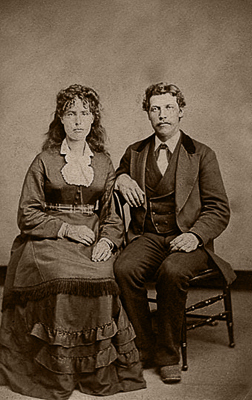 On 13 April 1876, John Lundberg married Lina Swanson. Lina was born Ingrid Svensdotter on 17 May 1847 in Ilsbo parish, Gävleborg län, Sweden, to tenant farmer Sven Svensson and his wife Kjerstin Nilsdotter. Ilsbo is located only 55 miles East of Ljusdal. Lina and her parents came to the United States in 1868. According the 1875 Minnesota Census, Lina and her family were living in Cambridge, MN.
On 13 April 1876, John Lundberg married Lina Swanson. Lina was born Ingrid Svensdotter on 17 May 1847 in Ilsbo parish, Gävleborg län, Sweden, to tenant farmer Sven Svensson and his wife Kjerstin Nilsdotter. Ilsbo is located only 55 miles East of Ljusdal. Lina and her parents came to the United States in 1868. According the 1875 Minnesota Census, Lina and her family were living in Cambridge, MN.
Jonas and Lina’s first child, Huldah Wilhelmina, was born in Athens Township, Isanti County, Minnesota on 21 January 1877. (Bethel Lutheran Church (Herman, MN) Membership Records, p. 4-5)
During 1877, Jonas and his brother Ole must have been looking for good land that they might homestead with their families. They no doubt read reports of locusts destroying the 1876 and 1877 grain crops on the prairie to the west. They were also trying to build their savings. "As a rule, a homesteader had to invest approximately one thousand dollars before his farm began to produce enough to sustain an entire household". (Ljungmark, Swedish Exodus, p. 55) By homesteading together, Jonas and Ole could help each other break the prairie, build log cabins and animal shelters, and save on the cost of jointly owned farm implements.
In the Spring of 1878 Jonas and Ole probably made their way from Athens Township in Isanti County to North Branch where they would have boarded the Lake Superior & Mississippi Railroad for the 40-mile journey south to St. Paul. Then they traveled 200 miles west on the Main Line of the St. Paul & Pacific Railroad through Willmar and Herman to Campbell, Minnesota. A regularly scheduled express stagecoach owned by Gray & Squires would have carried them 23 miles northwest from Campbell to the Fergus Falls Land Office. Fergus Falls was a bustling town of 680 people in 1878. After conferring with Soren Listoe, the Land Office Register, they might have rented horses at one of the two livery stables and set off on the 25-mile trip to Delaware Township in Grant County to select their prospective homesteads.
On 29 March 1878, Jonas filed a homestead application in Fergus Falls. And on 25 September 1878 Jonas and Lina and Huldah moved to Grant County, Minnesota and began to homestead a 71.5 acre parcel of land in what would be Delaware Township. Under the 1862 Homestead Act, settlers could clear and occupy land and be granted a "patent", or ownership, after 5 years for a nominal recording fee. Ole and his wife Betsey and their daughter Elna homesteaded adjacent land at the same time.
Grant County is located about 180 miles northwest of Minneapolis on the southeastern edge of what was the glacial Lake Agassiz, existing from 13,000-8,000 years ago and covering much of Saskatchewan, Manitoba, western Ontario, northern Minnesota, and eastern North Dakota. The land is fertile flat lakebed. It must have looked like promising agricultural land to Jonas and Ole, coming from the more forested and difficult to clear counties of Sherburne and Isanti to the East. The county was formed in March 1868 and named in honor of General Ulysses S. Grant.
"When the first settlers came to Grant county the broad prairies were unbroken by any tree or shrub. They bore a profusion of native grasses made bright in places by numerous wild flowers. Along the streams and near the lakes were found small groves of trees, consisting principally of oak, maple, ash, elm, birch and cottonwood. The pioneers found these lakes and streams teeming with fish - pickerel, pike, bass and perch; and on the plains and in the groves an abundance of game. Great flocks of geese and ducks were common; cranes, prairie chickens, grouse, deer and rabbits were secured with little difficulty. The natural resources of this region, and the beauty of the virgin country, with its exhilarating air and bright sunshine, were no doubt pleasing to the early comers, and they felt assured that here was a country that would abundantly reward their labor." (Larson, Constant. History of Douglas and Grant Counties Minnesota: Their People, Industries and Institutions. Indianapolis: B.F. Bowen & Company, Inc., 1916, p. 420)
Second daughter, Ellen Mary, was born 15 January 1879 on the farm in Delaware Township, Grant County, Minnesota. (Minnesota, Grant County, Birth Register, 1879. Grant County Courthouse, Elbow Lake)
"On October 6, 1879, a petition was presented to the board of county commissioners, signed by a majority of the legal voters of congressional township 128, range 43, praying that the township be organized and named "Delaware". The petition was granted. (Larson, History of Douglas and Grant Counties Minnesota, p. 416) Jonas and Ole were among the 16 men who signed the petition.
By June 1880, the family had made progress on the homestead, having tilled 29 acres and put 8 acres into permanent meadows. The farm produced 196 bushels of wheat, 20 bushels of Irish potatoes, 150 pounds of butter, and 18 tons of hay. Livestock included 2 milk cows, 1 ox, 2 calves, 2 sheep, 2 horses, 1 pig, and 12 chickens. The total value of the farm was $600. Farm production, sold and consumed, in 1879 was valued at $175. There did not appear to be any woodland on the property. (1880 US Census; Schedule 2, Productions of Agriculture, p.28, line 4)
The family would have gone to the nearby village of Herman to sell wheat and trade eggs and butter for sugar, coffee and other staples not grown on the farm. A dozen eggs sold for 10 cents, as did a pound of butter. The arrival of the St. Paul & Pacific Railway Company in 1871 made Herman the earliest successful commercial center in the county.
Third daughter, Hanna Carolina, was born 13 December 1881 on the farm in Delaware Township. (Minnesota, Grant County, Birth Register, 1881. Grant County Courthouse, Elbow Lake)
On 22 Nov 1882, Jonas filed in Stevens County his Final Papers for Naturalization and became a citizen of the United States. On the same day, his brother Ole and his neighbors Eric Channel and Andrew Selander also became citizens. (Stevens County District Court, Naturalization Records, 1873-1906, MHC SAM 37, roll 2, number 306)
On 23 May1883, having fulfilled the homesteading requirements, Jonas filed the final papers to claim the farm as his own. He stated, "I have a framed house 14x22 feet with several doors & windows, a good stable 12x36 feet, a well & 35 acres broken. Improvements worth $700." He had raised crops for 4 seasons. (John Lundberg (Grant County) homestead file, final certificate no. 3888, Fergus Falls, Minnesota, Land Office; Land Entry Papers, 1800-1908; Records of the Bureau of Land Management, Record Group 49; National Archives, Washington, D.C.)
However, by that time he knew that farming was not his calling. On 10 November 1883 "John Lundberg and wife" signed a warranty deed effectively selling their homestead to Elias Moses, a large local landowner, for $1200. With the proceeds he paid off his $500 mortgage debt and invested the remainder in his new career. (Recorder's Office, Grant County Courthouse, Elbow Lake, MN; Tract Index No. 1 Ranges 43-44, p. 22)
Shortly thereafter, Jonas’ brother, Ole, sold his homestead and became a hardware and lumber dealer in Barrett and Elbow Lake, Minnesota. Later he moved to Minneapolis to manage a larger lumber operation.
Becoming a Pastor
“So when he came to America, he gathered the pioneers on Sundays and read for them from one of Luther’s sermons or some other good sermon. After a while, they requested that he give short sermons of his own. Pastors in nearby congregations soon learned to know him as a true confessing Christian and talented youth. They encouraged him and led him more into spiritual work. An inner desire and urge to be a pastor now seemed nearer realization. He began to read and study whenever there was time, and together with other Christian young men, studied under Pastor J.A. Jackson.” (A Century of God’s Grace, p. 63)
The Swedish Evangelical Lutheran Bethel Congregation was organized in Herman, Minnesota, on 8 June 1880. John Lundberg, age 29, was a deacon and charter member.
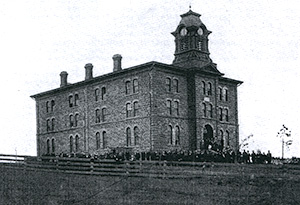
According to college records, Johan Olof Lundberg attended Gustavus Adolphus Academy in St. Peter, Minnesota, from 5 January 1881 to 15 April 1882 in preparation for the ministry. He was ordained on 17 June 1883 at Red Wing, Minnesota. Gustavus Adolphus was founded as Minnesota Preparatory School in 1862 in Red Wing, Minnesota, by the Swedish immigrant and Lutheran pastor, Eric Norelius. In 1863, the school then known as St Angsar's Academy moved to East Union in Carver county. Finally, in 1876 the school moved to St. Peter, where it was named in honor of the Swedish king Gustav Adolf II (1594-1632). The college was founded to provide Swedish Lutheran pastors and teachers to serve the Swedish immigrants settling in Minnesota.
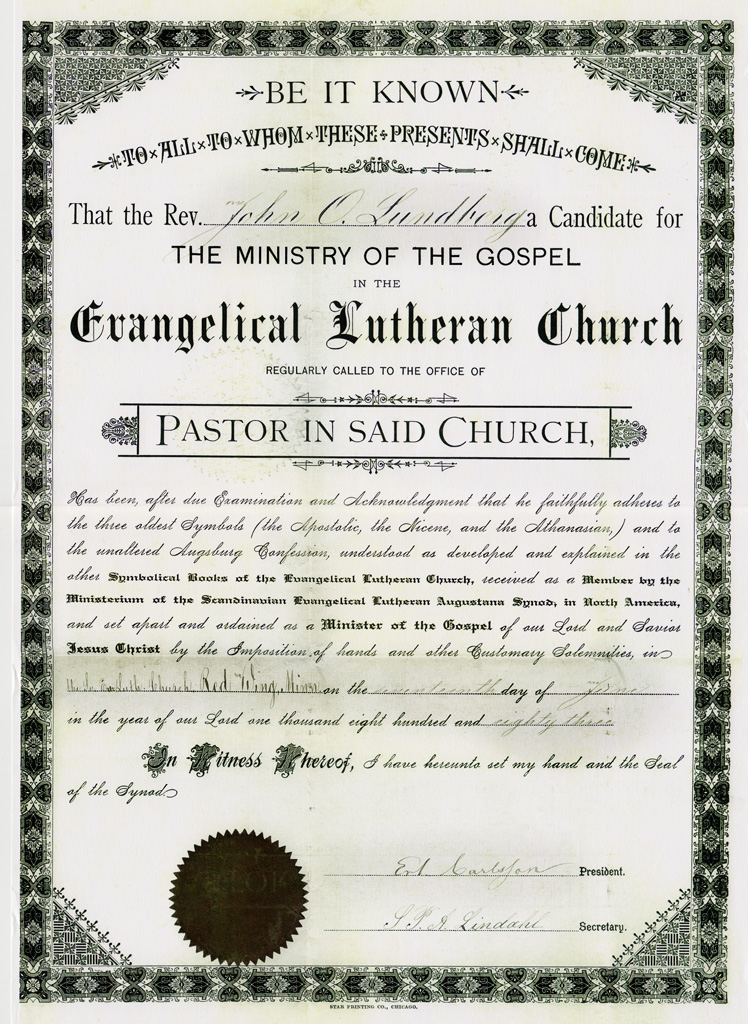

“He continued to study by himself which increased his knowledge of church history and theology. He was also able to converse very well in the English language. In the Minnesota Conference, he held various positions. The work of missions was closest to his heart and he often went to Canada, Dakota and northern Minnesota in the interest of mission work. His first congregation after his ordination was in Herman, Grant County, Minn. This charge comprised the greater part of the county. With youthful zeal, and a heart concerned for home missions, the young pastor took on the work with all his ability and fervor.” (
A Century of God’s Grace, p. 63)
“Pastor Peter Beckman was called to serve as pastor for fifty dollars a year. Owing to the many places the pastor had to visit, Mr. John O. Lundberg, one of the members of the congregation, who was living on a farm some nine or ten miles northeast of Herman, was called to preach once a month, at least, for twenty-five dollars. It was said that Mr. Lundberg had a good education and training from Sweden. In 1883 J.O. Lundberg was called as pastor to serve the Bethel Congregation [along] with Fridhem in Grant County, Emanuel in Traverse [County], and Becker in Stevens County. His salary was to be five hundred dollars. Of that amount Fridhem and Bethel promised to pay the one-third part together. Pastor Lundberg began his work sometime in the summer of 1883, since he was chairman of the extra business meeting that was held September 12th for the purpose of deciding upon the matter of building a parsonage. At that meeting it was decided that a parsonage should be built." (Gustafson, Rev. Carl A.E. Brief Historical Sketch of the Bethel Lutheran Congregation. Herman, MN: Bethel Lutheran Church, 1930, p. 5-6)
Herman grew rapidly in population from 184 in 1880 to 415 in 1885. (Hedstrom, Gary W. A Blossom on the Prairie: The History of the Herman, Minnesota Area Through 1900. Herman, MN: Herman Review, 1976)
Jonas and Lina’s first son, Oscar Augustinus, was born on 16 September 1884 in Herman, MN. (Minnesota, Grant County, Birth Register, 1881. Grant County Courthouse, Elbow Lake)
Pastor Lundberg was living with his wife, Lina, and four children, in the new parsonage in Herman by the time of the 1885 Minnesota Census. Note that the parsonage was built before the church. The Bethel Congregation met in homes until 1884, then in the Methodist Episcopal Church in Herman until 1901. "The prayer-meeting spirit of the earliest gatherings had much in common with the private devotional services among the early Swedish pietists". (Ljungmark, Swedish Exodus, p. 117)
“The primary activities of the congregation were the worship services. These services were all in Swedish. There was no Sunday School or Ladies Aid or Luther League. The services were first held in homes. Then according to the Herman Herald, published on August 23, 1883, “Scandinavian Evangelical Lutheran Congregation holds services at the Methodist Episcopal Church every third Sunday, at 3 p.m. Prayer meeting every Wednesday evening at 8 o’clock.” In 1884, eight members were confirmed and in 1886 there were four.”
"After a short period of liberalism, the Augustana Synod...turned conservative. It baptized children, confirmed them, and received as members those who stated an avowal. Its pastors upheld strong church discipline, kept a watchful eye on its members' church-going and banned secular tendencies, such as drinking, card playing, dancing, and theater, and they also opposed freemasonry." (Norman and Runblom, Transatlantic Connections, p. 198)
In June 1886 Jonas also began preaching every 2nd or 3rd Sunday at 3:00 PM at the Swedish Evangelical Church of Wheaton. (Wheaton Gazette. Wheaton, Minnesota, various issues , 1886-1888) Wheaton was officially chartered in 1887 and had 180 residents, wood sidewalks on both sides of the main street, a telephone line connecting the drugstore and the doctor's residence. (Wheaton Minnesota Centennial History 1887-1987. p. 325-326)
Around this time, Jonas also became pastor of the Swedish Evangelical Lutheran Immanuel Church, located in section 23 of Monson Township. Only a cemetery (2009) currently survives at this location.
Fourth daughter, Charlotta Christina, was born 4 April 1887. (Bethel Lutheran Church (Herman, MN) Membership Records, p. 4-5)
“On June 13, 1887 Rev. Lundberg resigned. But since he then began to serve churches at Wheaton and Monson, only a short distance away [in contiguous Traverse County], he was able to continue visiting Bethel once a month.” (Gustafson, Brief Historical Sketch of the Bethel Lutheran Congregation, p. 6 ) Also in 1887, Jonas organized the Swedish Evangelical Lutheran congregation of Elbow Lake. (Larson, History of Douglas and Grant Counties Minnesota, p. 445)
Arriving in Svea
Jonas had a growing family of five children. His wife Lina died in childbirth on 7 May 1888 at age 40 in Monson Township, Traverse County. (Traverse County, MN, Book "A" Register of Births and Deaths, p. 110, Recorder's Office, Wheaton, MN) Their sixth child, Victoria, died at birth and was buried with Lina. In 1894, Lina and Victoria would be reinterred in Svea Lutheran cemetery (Willmar Argus, 20 December 1894, p. 4).
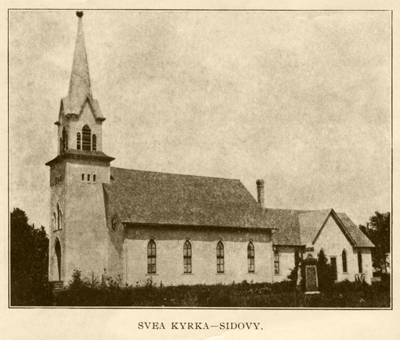
Jonas accepted the call in April 1888 and by that summer moved to Svea, Minnesota. His salary was $600 cash plus parsonage and feed for a horse and a cow. He was Svea's first resident pastor. Prior to Pastor Lundberg, the previous pastors had served the congregation intermittently, living elsewhere in the area. "Svea needed a man to live among its people rather than visiting them on Sundays" (A Century of God’s Grace, p. 17). At the time, Svea was affiliated with another church in the area, Christine of Lake Lillian. The salary was divided between the two churches; Svea $350 and Christine $250. Services were alternated between the two churches. In 1904, Jonas resigned from Christine church, thus allowing him to conduct services every Sunday at Svea. The town of Lake Lillian is approximately 10 miles southeast of Svea.
Why did Jonas move to Svea? There is a common link between the churches in Herman and Svea. Pastor C.J. (Peter) Beckman helped to organize the first congregation in Svea in 1870 and the Bethel Congregation in Herman in 1880. Peter Beckman was a traveling preacher based in Kandiyohi County.
"From the very beginning all of these churches adopted Swedish as their official language, but with the passage of time the language question became a highly divisive issue. Before the mass immigration surge of the 1880s, it presented no real problem, as everyone was convinced that English would inevitably replace Swedish in the context of religious worship. By the turn of the century, however, America had become the home of one out of every five Swedes, and the tide of opinion changed dramatically. The majority of Swedish-American churchgoers now wanted to retain Swedish, maintaining that it had become synonymous with their Christian faith. Swedish was not only a "holy language" but the indispensable medium of Swedish-American worship." (Ljungmark, Swedish Exodus, p. 118) Not until the 1920s did English become the predominant language in Swedish churches.
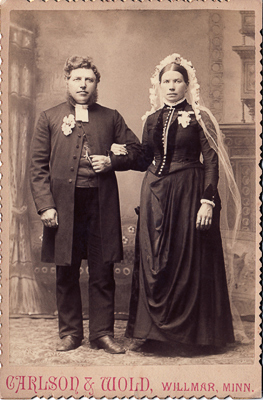 Before Jonas and his children moved into the Svea parsonage, he wrote a letter back to his Swedish homeland, inquiring about a suitable housekeeper to help care for his large family. A reply came from Anna Lisa Jönsdotter offering to be of assistance. She was born 23 June 1858 in Östmark, Värmland, Sweden. Anna came to America. Anna cared for the children and kept house for the Lundbergs in Svea. On 19 December 1888 Jonas and Anna were married in Svea, Minnesota. We are unsure if this marriage was arranged by family members.
Before Jonas and his children moved into the Svea parsonage, he wrote a letter back to his Swedish homeland, inquiring about a suitable housekeeper to help care for his large family. A reply came from Anna Lisa Jönsdotter offering to be of assistance. She was born 23 June 1858 in Östmark, Värmland, Sweden. Anna came to America. Anna cared for the children and kept house for the Lundbergs in Svea. On 19 December 1888 Jonas and Anna were married in Svea, Minnesota. We are unsure if this marriage was arranged by family members.
Jonas Lundberg was known as a 'man of action' while serving the Svea area. He worked to help in constructing a new church building, organized a "Young People's Society," later called a Luther League, and brought in a large number of new members to the congregation. Jonas also worked outside the pulpit organizing a home visitation program, and offering outstanding contributions to the secular community through the establishment of a creamery and the local telephone company. Jonas even served as chairman of the board of directors of the creamery cooperative for a time. He found time to be involved in other activities of his community. "1 Sep 1900 - Rev. J.O. Lundberg was a delegate from Whitefield Township to the convention to nominate republican candidates for county officers; convention held in Willmar." (The Centennial History: Kandiyohi County, 1970, p. 77).
Jonas was a member of the Republican party. Why? Early Swedish immigrants were almost all anti-slavery and joined Abraham Lincoln's Republican party and served in the Union Army during the Civil War. This strong party attachment continues to this day in rural central Minnesota.
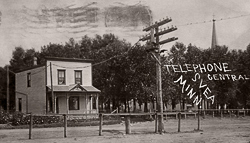 Jonas and Anna bought a 100 acre farm about 3 miles north of Svea, on the shore of Lake Waconda. They purchased the farm on 23 October 1903 from Erick and Anna Falk for $3600, subject to a mortgage of $2000. On 27 March 1906, they refinanced the property with a $2500 mortgage from The Board of the Ministerial Aid Fund of the Evangelical Lutheran Augustana Synod of North America. They sold the property on 9 February 1911 for $6150 to Peter N. Lindgren and paid off their mortgage loan. Oscar and Edla also lived on the farm in 1906 and early 1907. (Kandiyohi County Recorder's Office, Deed Record book, p. 190, 159; Mortgage Record book, p.455, 425)
Jonas and Anna bought a 100 acre farm about 3 miles north of Svea, on the shore of Lake Waconda. They purchased the farm on 23 October 1903 from Erick and Anna Falk for $3600, subject to a mortgage of $2000. On 27 March 1906, they refinanced the property with a $2500 mortgage from The Board of the Ministerial Aid Fund of the Evangelical Lutheran Augustana Synod of North America. They sold the property on 9 February 1911 for $6150 to Peter N. Lindgren and paid off their mortgage loan. Oscar and Edla also lived on the farm in 1906 and early 1907. (Kandiyohi County Recorder's Office, Deed Record book, p. 190, 159; Mortgage Record book, p.455, 425)
The Children
It was during these years in Svea that six children were born to Jonas and Anna Lundberg. Anna Laura was born 22 September 1890, Karl Johann Edward 17 March 1892, and Emilynn (Amy) Elizabeth 8 May 1894. The Census Record of 1895 shows Jonas and Anna Lundberg living in Whitefield Township, Kandiyohi, Minnesota with the following children at home: (family photo at this time period) Hulda, Ellen, Hanna, Oscar, Lottie, Laura, Karl and Amy.
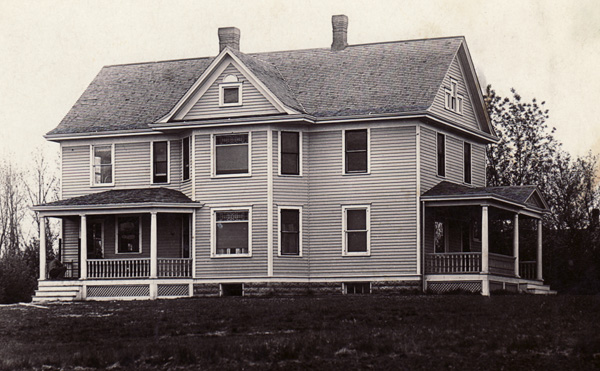
A daughter Albertina Charlotta was born 17 April 1896 and a son Berthold Rupert Verner on 9 July 1899. In the 1900 Census Record, Hulda was not listed in the household with the Lundbergs, but Albertina and Berthold were mentioned, living in Whitefield Township, with the rest of the family. The last child born to Jonas and Anna, Herbert Wilhelm Oliver, arrived on 9 February 1902. (Family photo of all or most members.) Jonas Lundberg was given the opportunity to confirm eight of his own children while serving Svea Lutheran: Hulda in 1892, Ellen in 1894, Hanna in 1896, Oscar in 1900, Anna Laura in 1905, Carl in 1906, Amy in 1908 and Albertina in 1910.
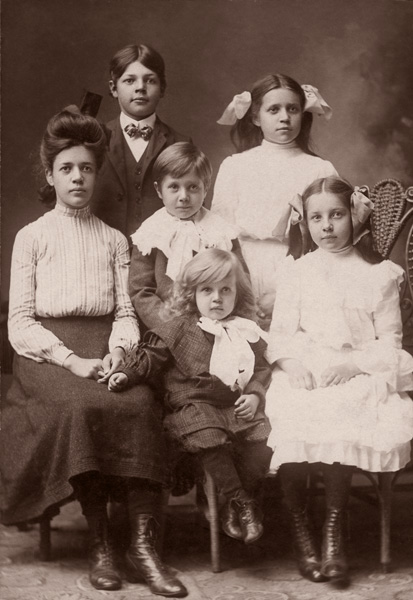
Jonas was well-loved in the Svea area. "Those children during Pastor Lundberg's time in Svea now among the older folks here, tell us they stood in awe of him, perhaps even afraid of him, and yet they were very fond of him and considered it a special occasion when he came to their homes." (A Century of God’s Grace, p. 19) Amy, a daughter of Jonas and Anna, remembered the younger Lundberg children playing in the study as Jonas worked to prepare his Sunday sermons. She noted this was allowed only if they played quietly so as not to disturb the Pastor's work. Amy recollected that they all adored their father, and it was a loving home. Jonas smoked a pipe. There were occasional instances when he would ask if anyone had seen his pipe, only to find that it was already in his mouth.
Jonas made some of his home visits on foot, although most were with his brown horses and buggy or sleigh. An account many in the Svea community remembered told how Jonas met up with a muddy road. The story relates how poor the road conditions were during his days in Svea. "Rev. Lundberg was a good horseman and always drove a lively spanking team. One Sunday morning he was on his way to hold forenoon services at the Christine church. The roads were bad. As he was passing somewhere in the neighborhood northeast of Roseland, he drove through a bad spot, and as the horses were floundering around in the mud, the whiffle-tree broke. The horses lunged forward and the Reverend gentleman, who holding tight on the lines, was jerked forward, over the dashboard, flat into the mire. The horses were well trained, however, and when Jonas called 'Kup, Kup, Kup', which was the vocable he used to summon them, they stopped. Rev. Lundberg headed his horses for the Olaf Lindgren place and when he arrived in the yard, he was a sight for sore eyes. His ministerial garb was plastered up with gumbo, his hands and cuffs were covered in mud; his genial face was like a near-total eclipse, and his starched white shirt bosom and collar were as a cross between a Mexican pinto and a map of Europe done in charcoal. 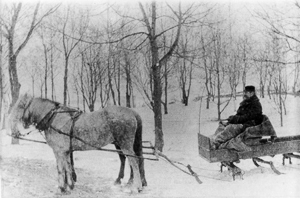 'Olaf, I believe you'll have to help me out. You'll have to preach for me today. I can't appear before the congregation in these clothes.' Lindgren agreed, hitched up a team of horses and drove to Christine church. (He probably studied his text on the way.) The Lindgren boys took another team and hauled out the preacher's buggy. They managed to find another whiffle-tree for him and hitched up his horses. After washing his hands and face, Rev. Lundberg drove back home to Svea where he preached in the church that afternoon - in other clothes of course." (A Century of God’s Grace, p. 20)
'Olaf, I believe you'll have to help me out. You'll have to preach for me today. I can't appear before the congregation in these clothes.' Lindgren agreed, hitched up a team of horses and drove to Christine church. (He probably studied his text on the way.) The Lindgren boys took another team and hauled out the preacher's buggy. They managed to find another whiffle-tree for him and hitched up his horses. After washing his hands and face, Rev. Lundberg drove back home to Svea where he preached in the church that afternoon - in other clothes of course." (A Century of God’s Grace, p. 20)
Two of Jonas' children died while Jonas was serving the Svea Lutheran congregation. Charlotta Christina died 22 April 1896 of lung fever (pneumonia) at the age of 8 years, 11 months and 29 days. Jonas' eldest daughter, Hulda Wilhelmina contracted consumption (now called tuberculosis) and died on 12 February 1906 at age 29. She had been living in Svea with her husband Albert Hegstrom.
Jonas served at Svea Lutheran Church from summer of 1888 to March 3, 1910. In 1903 the pastor's salary was raised from $535 to $800 per year. There was church expansion as well as a period of spiritual development."Pastor Lundberg applied the Word of God to everyday life. He spoke much about right Christian living. Because of Pastor Lundberg's absorbing interest in the Svea Lutheran Church and the Svea community, it is fair to suppose that he would have been very much pleased to have known that his grandson, John Lester Lundberg of New Jersey, has made some splendid contributions to this church...money for the church library, since known as the Lundberg Memorial Library. The largest gift was the Verdin chimes and automatic bellringer", (A Century of God’s Grace, p. 21).
Changes
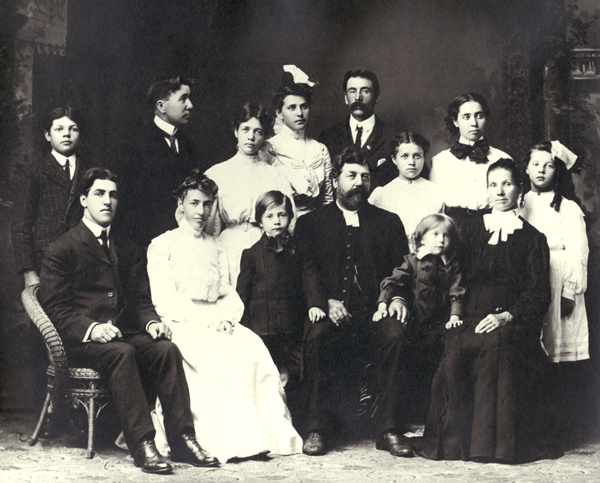 The photograph on the right shows the Lundberg family c. 1906. Left to right are: Karl, Oscar & Edla, Albert Hegstrom (whose wife Huldah died in Feb 1906), Laura, Vernon, Ellen & Alec Westerberg, Jonas, Amy, Herbert, Hanna (Bloomquist), Anna, and Tina.
The photograph on the right shows the Lundberg family c. 1906. Left to right are: Karl, Oscar & Edla, Albert Hegstrom (whose wife Huldah died in Feb 1906), Laura, Vernon, Ellen & Alec Westerberg, Jonas, Amy, Herbert, Hanna (Bloomquist), Anna, and Tina.
Pastor Jonas Lundberg resigned in 1907, but stayed after the congregation voted to not accept his resignation. He then rescinded it, and continued to serve until 1910 when he did resign, and moved to the Beckville parish, Meeker County, Minnesota in March of 1910. His salary was set at $400 a year. Jonas served Beckville and Cosmos, in addition to serving the Rosendale church six Sundays a year. The Census Record for 1910 shows J.O. and Anna Lundberg living in Greenleaf Township, Meeker County with the following children: Laura, Karl, Amy, Albertina, Vernon and Herbert.
First Lutheran Church of Cosmos also saw growth and changes when Jonas was there. The church renovated the building, a heating system was installed, and carpeting and new pews were purchased. "The congregation was looking forward to a long and successful pastorate by Pastor Lundberg, not realizing the chief Shepherd soon would call this devoted Pastor to his eternal reward." (50th Anniversary: First Lutheran Church of Cosmos, Minnesota 1893-1943, p. 16)
On Thursday morning, 25 May 1911 Jonas stepped into the chancel to commence the confirmation exercises when he was stricken with apoplexy. "Apoplexy: A venerable term for a stroke, a cerebrovascular accident (CVA), often associated with loss of consciousness and paralysis of various parts of the body." (Webster's New World Medical Dictionary, January 2003).
"He was carried into the parsonage, but did not lose consciousness at once. He was privileged to speak with some of his dear ones before he lapsed into the sleep from which there is no awakening." (Willmar Argus/Tribune, 31 May 1911) According to A Century of God’s Grace, p. 63, on two occasions, he may have had some indication of things to come. On one occasion he told his wife 'I have put all papers of any value in order if anything should happen'; and on Ascension Day Sunday as he was preparing to leave, Jonas had taken his purse out of his pocket, gave it to his wife with these words "take care of this, I won't need it." Jonas Lundberg was 59 years, 6 months, 23 days at his death.
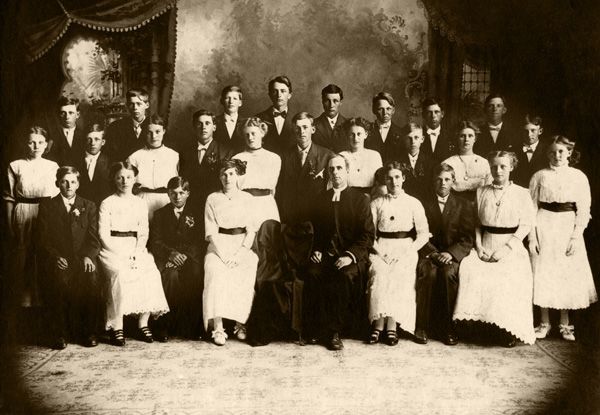
Funeral services were held at Beckville Lutheran church and a day later at Svea Lutheran church where Jonas was laid to rest in the Svea cemetery. According to the Willmar newspaper article, "not half of those present were able to get inside of the church." (Willmar Argus, 7 June 1911) His head stone has the following inscription in Swedish, and translated it states: 'You shall rest, and shall stand in your allotted place at the end of the days' Daniel 12:13. The confirmation class that was sadly bereft of their pastor was later confirmed by Rev. Linner of Litchfield. Laura Carlson was one of Jonas Lundberg's students from the confirmation class in Cosmos. In the photograph, she stands in the middle row extreme left. In December 1923 Laura Carlson would marry one of Jonas' sons, Karl Lundberg. Jonas is honored by the vacant chair draped with his black pastor robe.
 The church birth record does not include a middle name for Jonas. Ljusdal is located about 200 miles NNW of Stockholm and is one of about 2500 parishes in Sweden. In 1850, Ljusdal parish was composed of about 4,000 people living in 65 villages.
The church birth record does not include a middle name for Jonas. Ljusdal is located about 200 miles NNW of Stockholm and is one of about 2500 parishes in Sweden. In 1850, Ljusdal parish was composed of about 4,000 people living in 65 villages. Jonas “spent his youth quietly and uneventfully with his parents. The lad having desire and ability to learn easily, soon completed the instruction of the public school." Education for children 7 to 14 years old had been free and compulsory in Sweden since 1842. "At the age of sixteen he was confirmed by Pastor Karl Oscar Roos.” “ In his youth, Lundberg came in contact with the so-called Norrland’s Pietists. They gathered often around the Word of God and someone read one of Luther’s sermons. In this circle it soon became evident that the 17-year old Lundberg was in soul and heart one with them and ... they finally chose him as their reader.” (A Century of God’s Grace at Svea Evangelical Lutheran Church 1870-1970. Willmar, MN, 1970, p. 62)
Jonas “spent his youth quietly and uneventfully with his parents. The lad having desire and ability to learn easily, soon completed the instruction of the public school." Education for children 7 to 14 years old had been free and compulsory in Sweden since 1842. "At the age of sixteen he was confirmed by Pastor Karl Oscar Roos.” “ In his youth, Lundberg came in contact with the so-called Norrland’s Pietists. They gathered often around the Word of God and someone read one of Luther’s sermons. In this circle it soon became evident that the 17-year old Lundberg was in soul and heart one with them and ... they finally chose him as their reader.” (A Century of God’s Grace at Svea Evangelical Lutheran Church 1870-1970. Willmar, MN, 1970, p. 62)
 On the left is a photograph of a painting of the SS Nestorian, the sister ship of the SS Austrian. The SS Austrian, built in Glasgow in 1867 for the Canadian-owned Montreal Ocean Steamhip Company (also called the Allan Line), was 319 feet long and had a single smokestack, iron construction, 3 masts rigged for sail and rated speed of 11 knots. (Swiggum, Gery & Sue. Passenger Ship Arrivals Canadian Ports 1865-1899. CD-ROM, Wellington, Nova Scotia:TheShipsList-Research Inc., 2002) "Though powered by steam the Atlantic liners of the 1860s and 1870s were equipped with sails that could be used for additional speed in brisk tail winds". (Ljungmark, Swedish Exodus, p. 77) (photograph courtesy of http://www.norwayheritage.com)
On the left is a photograph of a painting of the SS Nestorian, the sister ship of the SS Austrian. The SS Austrian, built in Glasgow in 1867 for the Canadian-owned Montreal Ocean Steamhip Company (also called the Allan Line), was 319 feet long and had a single smokestack, iron construction, 3 masts rigged for sail and rated speed of 11 knots. (Swiggum, Gery & Sue. Passenger Ship Arrivals Canadian Ports 1865-1899. CD-ROM, Wellington, Nova Scotia:TheShipsList-Research Inc., 2002) "Though powered by steam the Atlantic liners of the 1860s and 1870s were equipped with sails that could be used for additional speed in brisk tail winds". (Ljungmark, Swedish Exodus, p. 77) (photograph courtesy of http://www.norwayheritage.com) On 13 April 1876, John Lundberg married Lina Swanson. Lina was born Ingrid Svensdotter on 17 May 1847 in Ilsbo parish, Gävleborg län, Sweden, to tenant farmer Sven Svensson and his wife Kjerstin Nilsdotter. Ilsbo is located only 55 miles East of Ljusdal. Lina and her parents came to the United States in 1868. According the 1875 Minnesota Census, Lina and her family were living in Cambridge, MN.
On 13 April 1876, John Lundberg married Lina Swanson. Lina was born Ingrid Svensdotter on 17 May 1847 in Ilsbo parish, Gävleborg län, Sweden, to tenant farmer Sven Svensson and his wife Kjerstin Nilsdotter. Ilsbo is located only 55 miles East of Ljusdal. Lina and her parents came to the United States in 1868. According the 1875 Minnesota Census, Lina and her family were living in Cambridge, MN.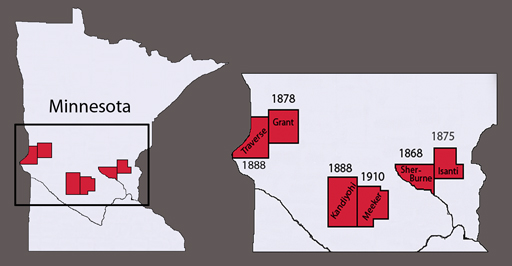
 According to college records, Johan Olof Lundberg attended Gustavus Adolphus Academy in St. Peter, Minnesota, from 5 January 1881 to 15 April 1882 in preparation for the ministry. He was ordained on 17 June 1883 at Red Wing, Minnesota. Gustavus Adolphus was founded as Minnesota Preparatory School in 1862 in Red Wing, Minnesota, by the Swedish immigrant and Lutheran pastor, Eric Norelius. In 1863, the school then known as St Angsar's Academy moved to East Union in Carver county. Finally, in 1876 the school moved to St. Peter, where it was named in honor of the Swedish king Gustav Adolf II (1594-1632). The college was founded to provide Swedish Lutheran pastors and teachers to serve the Swedish immigrants settling in Minnesota.
According to college records, Johan Olof Lundberg attended Gustavus Adolphus Academy in St. Peter, Minnesota, from 5 January 1881 to 15 April 1882 in preparation for the ministry. He was ordained on 17 June 1883 at Red Wing, Minnesota. Gustavus Adolphus was founded as Minnesota Preparatory School in 1862 in Red Wing, Minnesota, by the Swedish immigrant and Lutheran pastor, Eric Norelius. In 1863, the school then known as St Angsar's Academy moved to East Union in Carver county. Finally, in 1876 the school moved to St. Peter, where it was named in honor of the Swedish king Gustav Adolf II (1594-1632). The college was founded to provide Swedish Lutheran pastors and teachers to serve the Swedish immigrants settling in Minnesota.
 “He continued to study by himself which increased his knowledge of church history and theology. He was also able to converse very well in the English language. In the Minnesota Conference, he held various positions. The work of missions was closest to his heart and he often went to Canada, Dakota and northern Minnesota in the interest of mission work. His first congregation after his ordination was in Herman, Grant County, Minn. This charge comprised the greater part of the county. With youthful zeal, and a heart concerned for home missions, the young pastor took on the work with all his ability and fervor.” (A Century of God’s Grace, p. 63)
“He continued to study by himself which increased his knowledge of church history and theology. He was also able to converse very well in the English language. In the Minnesota Conference, he held various positions. The work of missions was closest to his heart and he often went to Canada, Dakota and northern Minnesota in the interest of mission work. His first congregation after his ordination was in Herman, Grant County, Minn. This charge comprised the greater part of the county. With youthful zeal, and a heart concerned for home missions, the young pastor took on the work with all his ability and fervor.” (A Century of God’s Grace, p. 63)
 Before Jonas and his children moved into the Svea parsonage, he wrote a letter back to his Swedish homeland, inquiring about a suitable housekeeper to help care for his large family. A reply came from Anna Lisa Jönsdotter offering to be of assistance. She was born 23 June 1858 in Östmark, Värmland, Sweden. Anna came to America. Anna cared for the children and kept house for the Lundbergs in Svea. On 19 December 1888 Jonas and Anna were married in Svea, Minnesota. We are unsure if this marriage was arranged by family members.
Before Jonas and his children moved into the Svea parsonage, he wrote a letter back to his Swedish homeland, inquiring about a suitable housekeeper to help care for his large family. A reply came from Anna Lisa Jönsdotter offering to be of assistance. She was born 23 June 1858 in Östmark, Värmland, Sweden. Anna came to America. Anna cared for the children and kept house for the Lundbergs in Svea. On 19 December 1888 Jonas and Anna were married in Svea, Minnesota. We are unsure if this marriage was arranged by family members.  Jonas and Anna bought a 100 acre farm about 3 miles north of Svea, on the shore of Lake Waconda. They purchased the farm on 23 October 1903 from Erick and Anna Falk for $3600, subject to a mortgage of $2000. On 27 March 1906, they refinanced the property with a $2500 mortgage from The Board of the Ministerial Aid Fund of the Evangelical Lutheran Augustana Synod of North America. They sold the property on 9 February 1911 for $6150 to Peter N. Lindgren and paid off their mortgage loan. Oscar and Edla also lived on the farm in 1906 and early 1907. (Kandiyohi County Recorder's Office, Deed Record book, p. 190, 159; Mortgage Record book, p.455, 425)
Jonas and Anna bought a 100 acre farm about 3 miles north of Svea, on the shore of Lake Waconda. They purchased the farm on 23 October 1903 from Erick and Anna Falk for $3600, subject to a mortgage of $2000. On 27 March 1906, they refinanced the property with a $2500 mortgage from The Board of the Ministerial Aid Fund of the Evangelical Lutheran Augustana Synod of North America. They sold the property on 9 February 1911 for $6150 to Peter N. Lindgren and paid off their mortgage loan. Oscar and Edla also lived on the farm in 1906 and early 1907. (Kandiyohi County Recorder's Office, Deed Record book, p. 190, 159; Mortgage Record book, p.455, 425)

 'Olaf, I believe you'll have to help me out. You'll have to preach for me today. I can't appear before the congregation in these clothes.' Lindgren agreed, hitched up a team of horses and drove to Christine church. (He probably studied his text on the way.) The Lindgren boys took another team and hauled out the preacher's buggy. They managed to find another whiffle-tree for him and hitched up his horses. After washing his hands and face, Rev. Lundberg drove back home to Svea where he preached in the church that afternoon - in other clothes of course." (A Century of God’s Grace, p. 20)
'Olaf, I believe you'll have to help me out. You'll have to preach for me today. I can't appear before the congregation in these clothes.' Lindgren agreed, hitched up a team of horses and drove to Christine church. (He probably studied his text on the way.) The Lindgren boys took another team and hauled out the preacher's buggy. They managed to find another whiffle-tree for him and hitched up his horses. After washing his hands and face, Rev. Lundberg drove back home to Svea where he preached in the church that afternoon - in other clothes of course." (A Century of God’s Grace, p. 20)  The photograph on the right shows the Lundberg family c. 1906. Left to right are: Karl, Oscar & Edla, Albert Hegstrom (whose wife Huldah died in Feb 1906), Laura, Vernon, Ellen & Alec Westerberg, Jonas, Amy, Herbert, Hanna (Bloomquist), Anna, and Tina.
The photograph on the right shows the Lundberg family c. 1906. Left to right are: Karl, Oscar & Edla, Albert Hegstrom (whose wife Huldah died in Feb 1906), Laura, Vernon, Ellen & Alec Westerberg, Jonas, Amy, Herbert, Hanna (Bloomquist), Anna, and Tina.